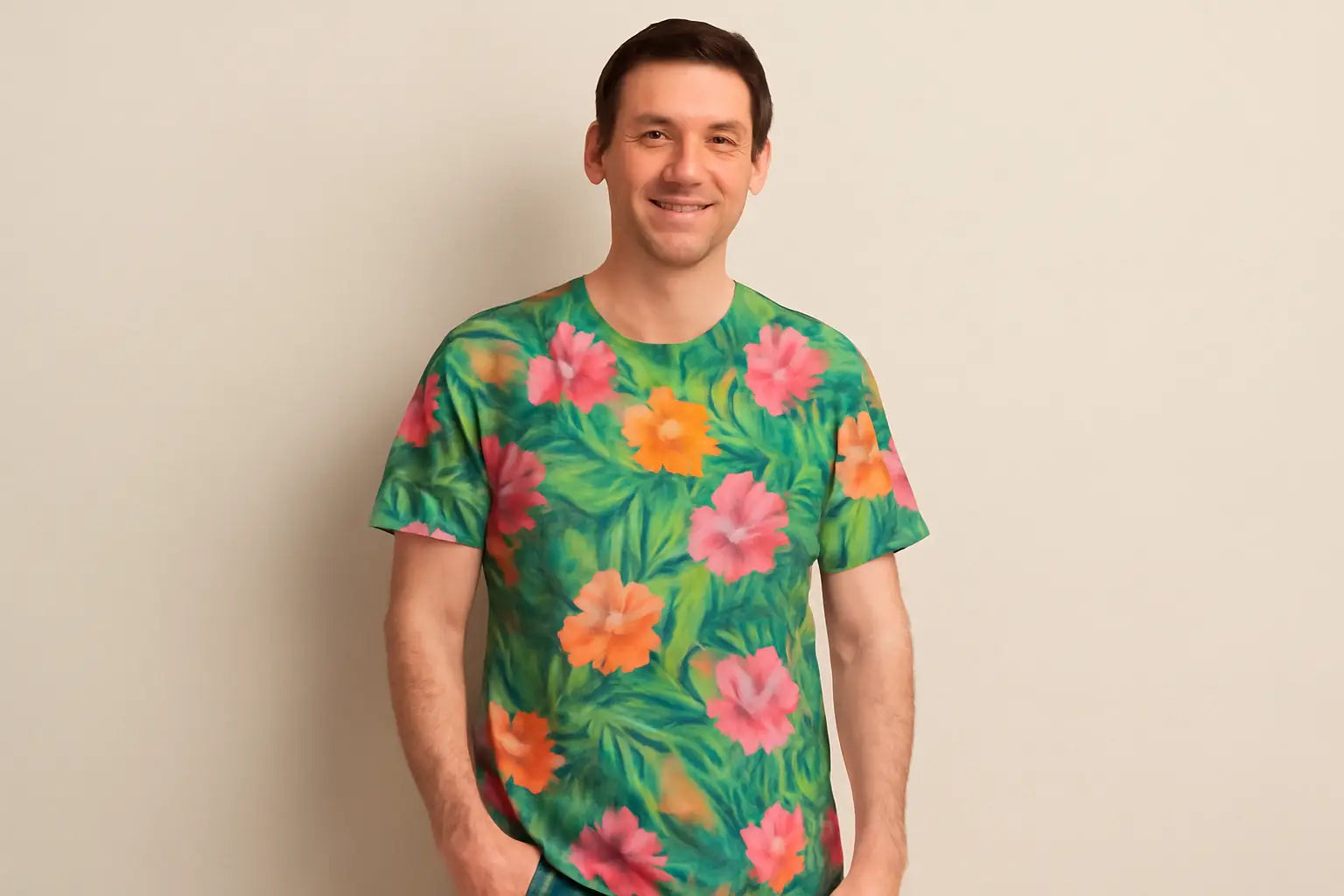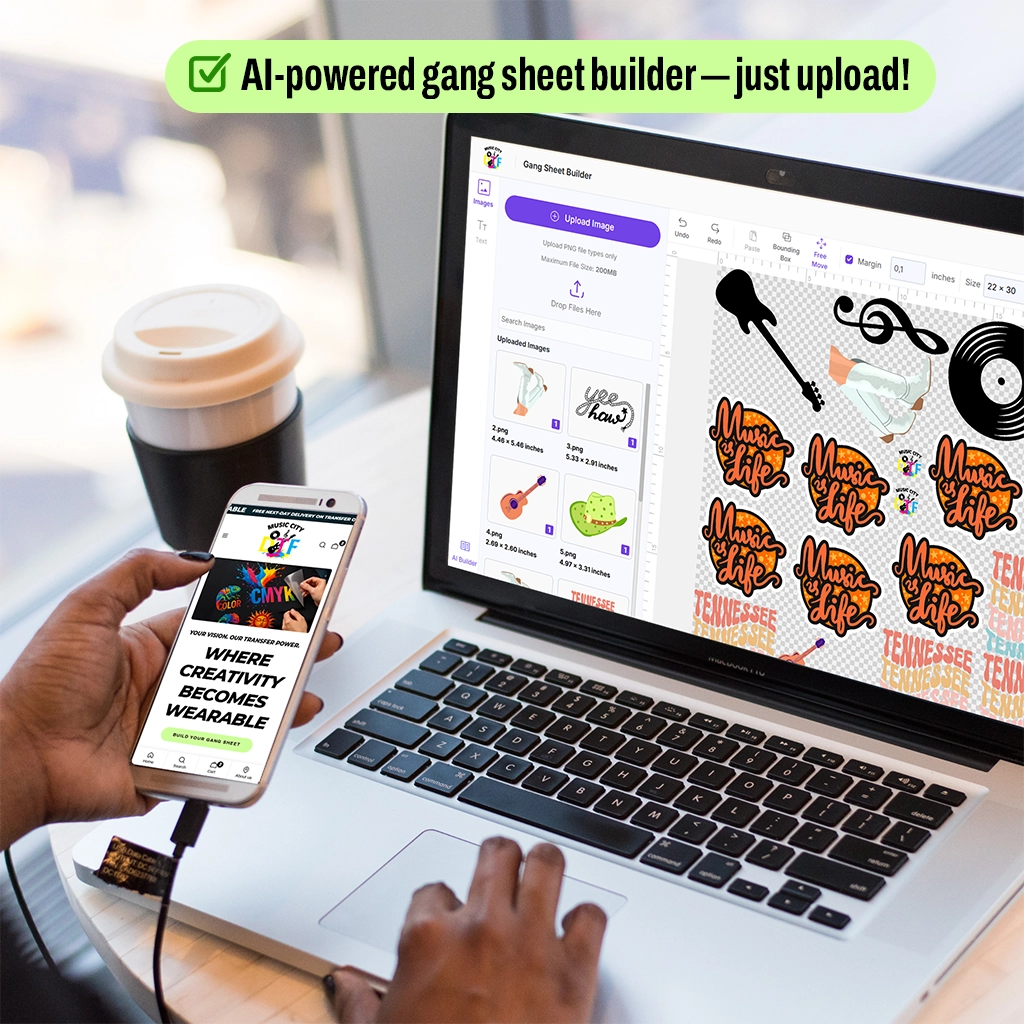When it comes to fashion trends, things change quickly. And if you are not fast enough to catch up, there’s a good chance that you can miss out on trends and possibly on profits. DTF All-over printing (AOP) is recently becoming the fastest-growing trend in custom apparel, helping small businesses and brands create unique collections, attract customers, and offer flexibility in creativity.
If you are looking to elevate your custom apparel game, consider AOP. In this post, we will cover all the basics so you can get started with all-over print DTF transfers without a hitch!
What is DTF All-Over Printing (AOP)?
All-Over Printing (AOP) is just what it sounds like: designs printed all over a shirt, edge to edge. Unlike small chest prints, AOP shirts make the whole garment (hoodie, sweats, etc.) a big, bold artwork.
Consider tie-dye, smooth graphics, or all-over prints – that’s AOP. Instead of just adding designs on some part of the clothes, AOP is all over the fabric, seamlessly integrating with the overall look and feel of the shirt, hoodie, sweatshirt, or whatever it’s printed on. And with gang sheet DTF for all-over prints, small business owners can fit multiple pieces or larger designs onto one sheet to save money.
Why choose all-over pattern shirts for your brand
AOP isn't just about how you print; it's about doing good business. Here's why:
-
It looks professional: AOP clothes catch attention and can cost more than normal prints, hence creating a luxury product.
-
It allows creativity: Do any pattern, color mix, gradient, or photo you want.
-
It’s the hottest trend: AOP is big in streetwear, sports clothes, and what you buy online.
- It stands out: AOP makes your clothes look cool and different from other brands.
And when you combine this with distortion-free DTF pattern placement (where transfers are installed so the design stays true to form, meaning no stretching or skewing), your all-over designs can flow smoothly across seams and panels, keeping your brand looking top-tier.
Why DTF is good for AOP
Direct-to-film printing gained popularity for clothes quickly because it's flexible, durable, and visually appealing. When you use it for AOP, it gets even better:
-
Works on most materials: You can use cotton, polyester, and blends. Not just polyester, as with sublimation.
-
High-Definition Colors: DTF provides designs that cover clothes from seam to seam without looking distorted.
-
Lasts long: DTF Prints stay bright even after a bunch of washes.
-
No minimum orders: DTF works whether you need one shirt or a whole bunch.
- Soft, wearable texture: AOP doesn’t have to feel uncomfortable, and DTF
The key is using DTF all-over design techniques that ensure crisp layouts and high-resolution all-over designs, so your finished product looks retail-ready.
How AOP DTF Printing Works
Here’s how all-over designs come to life with DTF:
-
Make it: Create patterns or artwork that covers the entire shirt.
-
-
Use high-resolution files (300 DPI) so details remain clear when you zoom in.
-
Use high-resolution files (300 DPI) so details remain clear when you zoom in.
-
Print it: A DTF printer puts your design on a PET film, adding a white layer so you can see it.
-
-
For AOP, you might need different prints to cover more space on the shirt.
-
For AOP, you might need different prints to cover more space on the shirt.
-
Add powder: The film is coated in powder that helps the design adhere to the fabric.
-
Set it: Heat causes the powder to stick to the film, preparing it for application to the shirt.
-
Press it: Press the film onto the shirt, ensuring it covers the entire area.
-
Some AOP designs may require more attention to ensure everything is covered.
-
Some AOP designs may require more attention to ensure everything is covered.
- Check it: One last press makes sure it's soft and sticks well.
For the cleanest look, pay attention to edge-to-edge DTF patterns and fabric panel alignment in DTF workflows. This ensures your design doesn’t look chopped at the seams.
Why Choose Music City DTF for DTF All-over printing
The better your printing partner, the better your AOP will be. That's where Music City DTF comes in.
Here’s why we’re the best choice for small business owners looking into AOP:
-
We know AOP: Not every DTF printer does all-over printing. We do, and we do it great.
-
Top-of-the-line materials: We use the finest inks, films, and powders to create prints that stand out and last.
-
Fast Turnaround: We produce AOP prints quickly without compromising quality.
-
Grow big: Trying your first AOP thing or selling a ton? We got you.
- Help when you need it: We assist with designs, placement tips, and printing so you're ahead from the start.
When you roll with Music City DTF, you don't just get prints; you get a crew that wants your brand to succeed.
Ready to get started with AOP? Start with our Custom Gang Sheet and a complimentary DTF Sample Pack to build collections that sell quickly and set your brand apart.
Frequently Asked Questions
1. What’s the difference between regular prints and all-over print DTF transfers?
Regular prints usually cover a small area of the garment, like a chest logo. All-over print DTF transfers cover the whole shirt, hoodie, or pants from edge to edge, turning the clothing itself into a bold design. This makes products stand out more and lets you charge premium prices.
2. How do I avoid alignment issues on AOP shirts?
Alignment is one of the biggest challenges in AOP. Utilize seamless print tips for DTF garments, such as designing with templates, checking panel flow, and pressing carefully around seams to achieve a seamless finish. This helps create a professional look for your AOP shirts, eliminating gaps and distortions.
3. Can I use gang sheets for all-over pattern shirts?
Yes! Gang sheet DTF for all-over prints is a smart way to save money and space. By arranging multiple sections of your all-over pattern shirts on one sheet, you reduce waste and improve efficiency when producing large or complex designs.
4. Will my designs stay sharp with DTF all-over printing?
Definitely! With the proper DTF all-over design techniques and high-resolution all-over designs (at least 300 DPI), your graphics will remain crisp, colorful, and detailed. This is especially important for gradient patterns, detailed photos, or full-body apparel.
5. How do I deal with seams or fabric panels in AOP?
Seams can sometimes distort designs, but using edge-to-edge DTF patterns and smart fabric panel alignment in DTF workflows makes a huge difference. Pick designs like repeats, abstracts, or gradients that look natural even if the seam shifts slightly.





